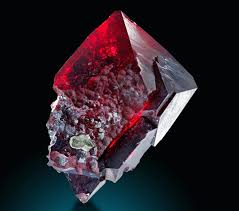
Cuprite: The Crimson Mirror of Vitality and Ancient Memory
With its deep, wine-red lustre and grounding energy, Cuprite emerges as a stone of both intense vitality and silent wisdom. Revered among collectors for its radiant hues and crystallised metallic presence, and cherished in metaphysical circles for its association with life-force and root chakra energies, Cuprite bridges the mineral and the mystical.

Geological Composition and Structure
Cuprite is a copper oxide mineral with the chemical formula Cu₂O, often forming in oxidised zones of copper ore bodies. Its distinct deep red colouring, ranging from blood-red to nearly black in some specimens, arises from its high copper content — typically around 88% copper by weight, making it a remarkably dense and richly pigmented stone.
Crystal forms include octahedral, cubic, and dodecahedral shapes, and though often found in granular or massive forms, well-formed crystals — especially when lustrous — are among the most visually striking in the mineral kingdom. Under light, polished or natural surfaces may reflect a vivid internal fire, akin to garnet or ruby, yet with an earthy, metallic grounding.
Major localities of Cuprite include:
-
Namibia – especially the famed Tsumeb Mine, known for sharply crystallised, gemmy specimens.
-
Arizona, USA – often associated with native copper and malachite in oxidised copper zones.
-
Russia and Congo (DRC) also produce significant material.
Energetic Properties and Healing Potential
Cuprite’s metaphysical associations lie primarily with the Root Chakra (Muladhara). It is considered a stone of survival, stamina, and life-force energy. Its intense grounding properties are thought to aid in times of insecurity, instability, or emotional fatigue — especially when one feels disconnected from their physical existence.
In energy work, Cuprite is often recommended to:
-
Stimulate vitality and support adrenal balance.
-
Ease fears linked to scarcity, ageing, or mortality.
-
Anchor ethereal or spiritual experiences into embodied awareness.
-
Strengthen a sense of inner sovereignty and autonomy.
Its strong connection to Divine Feminine energy, particularly the archetype of the Earth Mother, is noted by some traditions. This makes it a nurturing yet empowering stone — one that encourages both receptivity and self-command.
Collectibility and Natural Beauty
In the world of mineral collectors and connoisseurs, Cuprite occupies a fascinating niche. It is highly prized in its crystalline form, especially when translucent and gem-quality — a rarity due to its opacity and fragility. The finest specimens display sharp octahedral formations with a metallic lustre and rich crimson hue, often nestled amongst native copper or malachite.
One of Cuprite’s most captivating traits is its natural patina — a deepening oxidation that gives aged pieces an almost mystical, ancient character. In raw form, Cuprite’s surfaces may weather to velvety textures or display mirror-like flashes, enhancing its aura of elemental presence. Such characteristics make each specimen unique, and in the context of raw crystal jewellery, these natural nuances elevate Cuprite beyond mere ornamentation into the realm of wearable talismans.
Comparison with Other Root Chakra Stones
Cuprite is often compared to other grounding stones like Hematite, Red Jasper, and Smoky Quartz, but its intensity sets it apart. While Hematite offers a cerebral form of grounding and Red Jasper supports physical stamina, Cuprite dives deeper into cellular vitality and primal life force. It’s more emotionally penetrating, particularly suited to shadow work or integrating ancestral energies.
Compared to Garnet, which also shares a red hue and regenerative symbolism, Cuprite feels more subterranean — more earth-bound than fire-touched. For those seeking a mineral specimen ring or necklace that holds not only beauty but deeply transformative potential, Cuprite is a singular choice.

Use in Raw Crystal Jewellery
Despite its relative softness (Mohs 3.5–4) and sensitivity to handling, Cuprite is increasingly sought-after in handmade gemstone rings and mineral specimen necklaces. When stabilised or protected in bezel settings, it becomes a radiant centrepiece, often contrasted with complementary stones like Chrysocolla or Native Copper.
Oryssia’s designs often highlight such raw beauty — preserving Cuprite’s natural form, oxidation patterns, and matrix inclusions, allowing wearers to connect with the mineral in its unaltered, most powerful state.
Wearing Cuprite in jewellery can support:
-
A sense of energetic anchoring throughout the day
-
Deepening meditation and breathwork
-
Subtle realignment of survival-based fears or inherited energetic imprints
Cultural Echoes and Earth Memory
Though not as mythologised as stones like Lapis or Jade, Cuprite’s visual and energetic qualities evoke archetypes of blood memory, ancestral wisdom, and the sacred feminine. Some practitioners believe Cuprite helps to awaken cellular memory, acting like a key to past-life information or transgenerational emotional patterns.
In shamanic traditions, its high copper content is seen as a conductor — not just of electricity, but of subtle energies. This makes it a potent ally for energy workers and ritual practitioners who seek to ground cosmic insight into human form.
Closing Note
Whether set in a minimalist crystal specimen ring or cradled in a bold mineral specimen necklace, Cuprite is not simply a beautiful stone — it’s a mirror of resilience, sovereignty, and the ancient red pulse of Earth herself.
For those drawn to jewellery that transcends aesthetics — that speaks in symbols, roots into the body, and glows with primeval fire — Cuprite offers a rare, transformative companion.